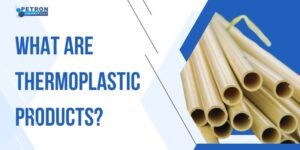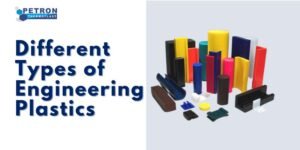Know About The Significance And Various Usages of PTFE Materials
Polytetrafluoroethylene (PTFE) is an extraordinary polymer. It is not only highly chemical resistant, durable, flexible, electrically and thermally resistant, but it is also a very cost-effective alternative for high-performance seals and ‘O’ rings. Let’s discuss PTFE materials in detail.
What exactly is PTFE?
PTFE, or Polytetrafluoroethylene, is a fluoroplastic class of high-performance plastics with distinct properties. PTFE, also known as Teflon, was discovered in 1938 by scientist Roy J. Plunkett. It is the most extraordinary fluoropolymer and has the best temperature, chemical resistance, and nonstick properties.
Polytetrafluoroethylene (PTFE) is a tough and flexible elastomer with good tensile strength but exceptional chemical, thermal, and electrical resistance. PTFE comprises a sequence of carbon atoms with two fluorine atoms bonded to each carbon. These fluorine atoms encircle the carbon chain, resulting in a dense molecule with very strong carbon-fluorine bonds and a polymer framework that is chemically inert.
 What are the key characteristics of PTFE?
What are the key characteristics of PTFE?
While a plastic molecule has a carbon chain with hydrogen atoms attached, the hydrogen atoms in a Polytetrafluoroethylene (PTFE) structure are replaced with fluorine atoms. It drastically alters the material’s properties, and PTFE, like other fluoroplastics, has unique properties:
- Extremely high working temperatures,
- Nonstick properties,
- Surface with low friction
- Chemical and solvent resistance is extremely high.
- Electrical resistance is extremely high.
- Weather, UV light, and corrosion resistance
- Non-toxic, inert, and biocompatible.
What are the benefits of PTFE?
PTFE also has a wide operating temperature range of -30°C to +200°C, a hardness range of 70 to 85 IRHD, and is simple to clean. Best of all, given these positive characteristics, PTFE is a relatively inexpensive elastomeric option for seals and ‘O’ rings.
The advantages of PTFE include:
Because of the presence of carbon-fluorine bonds in PTFE, which is widely regarded as the strongest single bond in organic chemistry, it has high flexural strength and is chemically inert.
It also has outstanding electrical insulation and dielectric properties; is extremely weatherable and non-adhesive; is resistant to water; has the least coefficient of friction of any solid.
- The best price-to-performance ratio,
- +260°C continuous working temperature – This is the highest working temperature for any fluoroplastic,
- Nearly all chemicals are resistant to it,
- PTFE has a low friction surface that even a gecko would slip on,
- Electrical resistance is extremely high and
- Colour that is translucent (when the proper raw polymer grade is chosen).
Chemical resistance of PTFE:
PTFE’s chemical resistance is potentially its most impressive feature. Simply put, at room temperature, no solvents can dissolve PTFE. In fact, except for a few chemical agents such as chlorine trifluoride and elementary fluorine, PTFE’s only real weakness is its relatively poor resistance to high-energy radiation, which induces the PTFE molecule to break down.
What is the purpose of PTFE?
Because of its extraordinary properties, PTFE materials can withstand even the harshest environments and are thus suitable for use in various applications. This fluoroplastic is ideal for food and beverage manufacturing, including cooking equipment, food wrappings, conveyor belt rollers, temperature sensor casing, and nonstick surface covers.
PTFE can be used to make various products in the chemical industry, ranging from gaskets to vessel linings and chemical tanks. PTFE is also widely used in high-temperature applications ranging from fire protection to terminal insulating material on heating elements and jet engines, UV lamps, and external aircraft fittings.
Because of its advantageous properties, PTFE can be used in many applications. Seals (including PTFE “O” rings), PTFE gaskets, valves, wire insulation, insulated transformers, bearings, surface coatings, chemical processing equipment, chemical transport, and PTFE rubber diaphragms are just a few examples.
PTFE is an excellent material for medical applications and the manufacture of internally and externally life-saving machinery such as catheters, bio-containment vessels, syringes, and sutures. This fluoropolymer is also ideal for electrical insulation and electronic component protection.
Is PTFE considered a metal?
PTFE, while not technically a plastic, is effectively considered one due to its properties. PTFE is plastic, not metal. Metal’s electrical conductivity is one of its distinguishing characteristics, whereas PTFE is insulative. It’s also not rubber, even though it appears to be.
Rubbers, like plastics, are polymers with the distinguishing feature of elasticity. Rubbers can be deformed, but unless completely broken, they will return to their original shape. Plastics, on the other hand, are described by their plasticity, meaning their shape and form can be easily manipulated by heat or force. PTFE falls under the latter category.
Top 10 Popular Industries Uses of PTFE Materials | In which industries are PTFE used?
Polytetrafluoroethylene (PTFE) is a synthetic fluoropolymer known for its exceptional chemical resistance, non-stick properties, and high-temperature resistance. It’s widely used across various industries for its unique characteristics. Here are the top 10 popular industries that use PTFE materials:
- Chemical Processing Industry: PTFE’s resistance to corrosive chemicals and high temperatures makes it a preferred choice for manufacturing components such as gaskets, seals, and linings used in chemical processing equipment.
- Electronics and Electrical Industry: PTFE is used for insulation in wiring, cable jackets, and connectors due to its excellent dielectric properties and ability to withstand high voltages.
- Automotive Industry: PTFE is used in automotive applications for components like gaskets, seals, O-rings, and bearings, where its resistance to chemicals, heat, and friction is crucial.
- Medical and Pharmaceutical Industry: PTFE’s biocompatibility and resistance to chemicals make it suitable for medical applications, including as coatings for medical devices and components of laboratory equipment.
- Food and Beverage Industry: PTFE’s non-stick properties are valuable in food processing equipment like non-stick cooking surfaces, conveyor belts, and seals, as they help prevent sticking and contamination.
- Aerospace Industry: PTFE is used in aerospace for applications like wiring harnesses, tubing, seals, gaskets, and bearings due to its ability to withstand extreme temperatures and harsh conditions.
- Oil and Gas Industry: PTFE’s resistance to chemicals and high temperatures makes it suitable for use in valves, seals, gaskets, and other equipment used in the oil and gas extraction and refining processes.
- Textile Industry: PTFE-coated fabrics and materials are used in textiles for their non-stick properties, water and stain resistance, and durability, making them suitable for items like waterproof clothing and industrial filters.
- Packaging Industry: PTFE is used in the packaging industry for applications like heat-sealing bands and conveyor belts, where its non-stick properties prevent adhesion during packaging processes.
- Environmental and Water Treatment Industry: PTFE is used in water treatment applications for its chemical resistance and non-stick properties. It’s used in components like gaskets, seals, and linings for pipes and tanks.
Petron Thermoplast makes a wide range of plastic products for different industrial requirements. Our products are of high quality. Hence, you can get our best quality PTFE materials reasonably priced.







